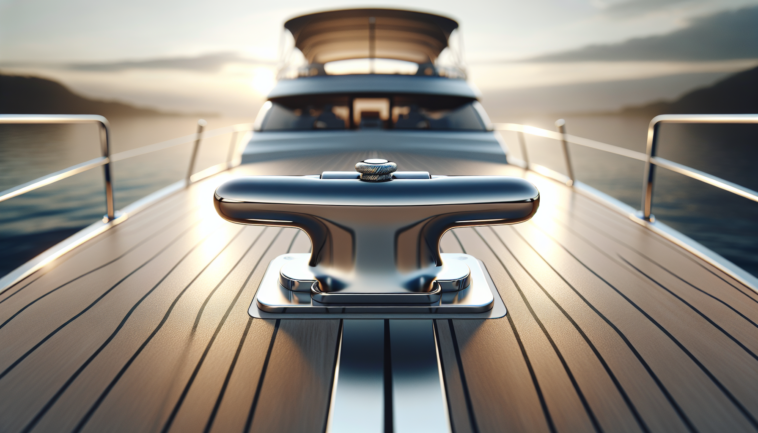Have you ever wondered what the purpose of a cleat is in boating? Cleats, those small yet essential devices found on the deck or sides of boats, serve a crucial function in securing ropes and lines. They provide a sturdy attachment point, allowing boaters to tie off and secure their vessels safely, whether it be at the dock or out on the water. Without cleats, the process of mooring and docking would become a precarious and challenging task. So, if you’ve ever been curious about the role that cleats play in boating, read on to discover their significance and how they ensure a smooth sailing experience.
Definition of a Cleat
A cleat is a fitting commonly found on boats that serves as a secure fastening point for ropes or lines. It is typically made of durable materials such as stainless steel, aluminum, or plastic, and comes in various shapes and sizes depending on its intended use. Cleats can be found on different parts of a boat, including the bow, stern, and sides.
Material and Shape
Cleats are usually designed to withstand the harsh marine environment, so they are typically made from corrosion-resistant materials like stainless steel or aluminum. The shape of a cleat can vary, but the most common designs include horn cleats, pull-up cleats, pop-up cleats, flip-up cleats, and vertical cleats.
Location and Mounting
Cleats are strategically placed on a boat to ensure optimal functionality. They are often mounted on the gunwales (the upper edges of a boat’s side) or on the deck, depending on the type of boat and its intended use. The positioning of the cleats is crucial for efficient boat handling and safe docking and mooring.
Importance of Cleats in Boating
Cleats play a crucial role in various aspects of boating, providing essential functions that ensure the safety and security of both the boat and its occupants.
Securing the Boat
One of the primary purposes of cleats is to secure the boat by securing lines or ropes to prevent it from drifting or coming loose. Cleats provide a reliable way to tie the boat securely to a dock or mooring buoy, allowing for peace of mind while leaving the boat unattended.
Docking and Mooring
Cleats are essential for docking and mooring maneuvers. By securing the boat with lines attached to strong cleats, boaters can effectively control the boat’s position and prevent it from drifting away. Cleats provide a solid anchor point to safely tie the boat during the docking and mooring process.
Towing Other Vessels
Cleats are also crucial when towing other vessels. Whether you are towing a disabled boat or pulling a water toy, cleats provide a secure attachment point for the towline. By using properly mounted and strong cleats, you can ensure a reliable connection for towing without the risk of the line coming undone.
Passenger Safety
Cleats can also contribute to passenger safety on a boat. By utilizing cleats to secure lines and ropes, you reduce the risk of tripping hazards caused by loose lines. Cleats provide a tidy and organized way to secure lines, ensuring a safe and clutter-free environment for passengers to move about the boat.

Types of Cleats
There are several types of cleats available, each with its own unique design and functionality. Understanding the different types can help you choose the right cleat for your specific boating needs.
Horn Cleats
Horn cleats are the most traditional and widely used type of cleat. They feature two horns or posts that provide multiple attachment points for lines. The horns can be straight or slightly curved, allowing for quick and secure line attachment. Horn cleats are versatile and can handle various line sizes, making them suitable for a wide range of boats.
Pull-Up Cleats
Pull-up cleats are designed to remain flush with the deck when not in use, minimizing the risk of tripping hazards. With a simple pull or lift, the cleat rises above the deck to provide a secure attachment point for lines. This type of cleat is popular on boats where a sleek deck appearance is desirable.
Pop-Up Cleats
Similar to pull-up cleats, pop-up cleats also remain flush with the deck when not in use. However, instead of manually pulling or lifting the cleat, pop-up cleats are operated with the push of a button or a hydraulic system, making them more convenient for boaters seeking easy use.
Flip-Up Cleats
Flip-up cleats combine the functionality of horn cleats and the space-saving design of pull-up or pop-up cleats. They feature a fold-down mechanism that allows the cleat to lie flat when not in use, minimizing deck obstructions. When needed, the cleat flips up, providing a sturdy attachment point.
Vertical Cleats
Vertical cleats are commonly found on sailboats and larger vessels. As the name suggests, they are mounted vertically, allowing for easy line adjustment and varying attachment angles. Vertical cleats can handle heavy loads and provide excellent holding power in demanding conditions.
Choosing the Right Cleat
When it comes to choosing the right cleat for your boat, several factors should be considered to ensure a secure and reliable attachment point.
Boat Size and Weight
The size and weight of your boat play a significant role in determining the appropriate cleat size and holding capacity. Larger boats with heavier loads will require larger and more robust cleats to handle the increased forces and stresses.
Cleat Holding Capacity
It is essential to consider the holding capacity of a cleat to ensure it can withstand the expected loads. Cleats are typically rated for specific weights or loads, so selecting a cleat with a sufficient capacity will prevent any accidental failures or damage.
Installation Considerations
Proper installation of cleats is crucial to their functionality and durability. Consider the mounting location, the number of cleats needed, and the type of mounting hardware required. Consult your boat manufacturer’s guidelines or seek professional advice to ensure accurate installation.
Maintenance of Cleats
To prolong the lifespan and functionality of your cleats, regular maintenance is necessary.
Regular Cleaning
Saltwater and dirt can accumulate on cleats, leading to corrosion and reduced performance. Regularly clean your cleats with fresh water and mild soap to remove any grime or debris. Additionally, applying a protective coating or lubricant can help prevent corrosion.
Inspecting for Damage
Periodically inspect your cleats for any signs of damage or wear. Check for cracks, loose screws, or any other structural issues that may compromise their functionality. Promptly address any damage by repairing or replacing the cleats as needed.
Replacing or Repairing Cleats
If your cleats are damaged beyond repair or are no longer suitable for your boating needs, it is crucial to replace them promptly. Consult with a marine professional or refer to the manufacturer’s guidelines to ensure proper installation of the new cleats.
Alternative Boat Tie-down Methods
While cleats are widely used and reliable, it is worth considering alternative tie-down methods and understanding their limitations.
Cleat Limitations
Although cleats are versatile and effective, they do have their limitations. Cleats require adequate mounting points on a boat’s structure, limiting their placement options. Additionally, cleats are designed for specific line sizes and configurations, so using lines that are too large or improperly attaching lines to cleats can compromise their performance.
Cleat Alternatives
For boaters seeking alternative tie-down methods, there are several options available. Some alternatives include using padeyes, rope clutches, or tow hooks. Each alternative method has its own advantages and disadvantages, so it is essential to research and select the option that best suits your specific boating needs.
Conclusion
Cleats are an essential component of boating, serving a variety of functions that contribute to the safety and security of both the boat and its occupants. By understanding the different types of cleats, choosing the right one for your boat, and properly maintaining them, you can ensure reliable and efficient boat handling, docking, and mooring. While cleats are widely used and effective, it is also beneficial to explore alternative tie-down methods to best suit your individual boating preferences. Ultimately, cleats provide a reliable and adaptable solution for securing lines and ensuring a safe and enjoyable boating experience.







